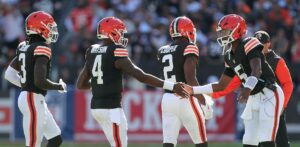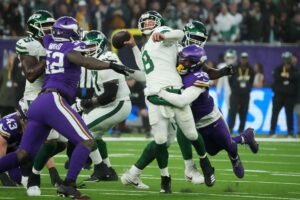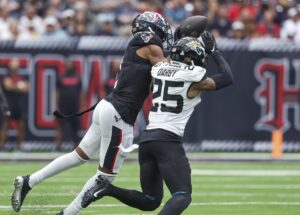Through the first few weeks of the NFL season, teams will flash or fade. But underlying everything is an analytical line that reveals some poignant factor that often arrives to reverse early season disappointment or success. Weeks six through ten of the season reveal the flaws of every single team, areas that need addressing, and where teams can grow. Then, in weeks ten through the Super Bowl, the hope is the most resilient team will coach and manage their way to mitigate those mistakes. During the first six weeks of the season, a lack of finishing the defensive attack haunted, but did not harm the Kansas City Chiefs. Then, in week seven, the battle-hardened Derek Carr magically shrugged off a back injury, punched a hole in those mistakes, and brought the Oakland Raiders roster together for an indelible 31-30 comeback victory. The game was astonishing and emotional – a production of offensive finesse and defensive woes. A compilation of the best of times, and the worst of times, the Chiefs week seven stats breakdown was a tale of two units.
Kansas City Chiefs Week Seven Stats and Charts – A Tale of Two Units
Chaos Theory
To control chaos, teams cannot battle for 40 or 50 minutes, and then expect a victory. Effective control comes about by fighting for 60 minutes against the bane of momentum; the Raiders won as they battled for all 60 minutes. The complete trajectory of the game was a chaos line of up and down. Although neither team controlled it purely until the final whistle blew, there were several moments where either the Chiefs or Raiders could have grasped momentum and went on a run.
The first point came for the Raiders. Shortly after Alex Smith led the Chiefs on a five-minute opening field goal drive, Raiders wide receiver Amari Cooper aggressively started his resurgence, capping off a two-minute drive with a 38-yard flea flicker touchdown grab.
The quick strike from the Raiders could have took the wind from the sails of the Chiefs. Instead, they responded with a touchdown of their own, dominating in the run game, and physically owning the Raiders defense. But, as the rest of the first half went, the Raiders did the same to the Chiefs defense. As most rivalry matchups go, there is nothing about precedent, and instead everything about the emotional moment.
The emotional moment epitomized one of the most shocking moments of the game. With six minutes left in the second quarter, Carr attempted to run up the middle, but was met by Allen Bailey. A charged Marcus Peters committed an egregious error by flying in and nailing Carr. The hit was debatably clean by the rules, but in nature, was dirty and unwarranted.
An ensuing scuffle broke out between the Raiders and Chiefs, and Peters continued to get heated – then flies in Marshawn Lynch, from the sideline, attempting to remove Peters and protect his quarterback. During that moment, Lynch contacted the referee, and was ejected. A moment that was shocking, unexpected, but very Lynchian in process.
The fight and penalties, however, did not directly affect the outcome or chaos of the game. Yes, the rivalry was heated, but the Raiders went on to have a field goal blocked by Eric Murray. When chaos should have gone in favor of the Raiders due to the penalty, the Chiefs field goal block could have established complete control. Instead, the offense settled for a field goal, while the Raiders missed another one. The Chiefs meandered into half with a 20-14 lead.
The second half showed the resiliency and magic of Carr and the wisdom of Andy Reid. When both defenses could have responded and shut down the opposing offense, both offenses struck with touchdowns and field goals. Again, neither team was able to impose chaos or control.
Finally, control was asserted in the final minutes when the Raiders pass rush stepped up in the biggest moment of the game. With four minutes left, the Chiefs had a chance to run out the clock, and ice the game for a 30-24 victory. The Raiders would have none of that; Khalil Mack and Denico Autry sacked Smith and forced a punt.
What occurred from there sealed the game. Carr took his team 85 yards for the gut wrenching 31-30 victory. And it was that drive that revealed the ugliest factors for the Chiefs defense moving forward.
The Good
A week after producing at a low rate, the poignant Reid offense returned to effective and electric numbers. Not every drive was a touchdown, there were factors that could have been improved, but the meta job was done – Smith led the team to score 30 points.
Diverse play-calling established determined plays that helped to create those 30 points, and return Smith to a 127.3 quarterback rating, 69 percent completion percentage, while averaging 9.5 yards per completion. The efficiency in the short game led to production on the deep ball as Smith completed four of five attempts to the deep cones of the field.
To extrapolate on the offensive attack, Reid opted to utilize more targets than any other game. Not only were ten different targets used, but four players were targeted on those five deep passes. Tyreek Hill led the charge by catching two on exterior routes, Demarcus Robinson caught a 33-yard exterior lane pass on, and Albert Wilson hauled in a pass tipped by Raiders safety Reggie Nelson (the latter ought to have been a drop, less Wilson’s concentration in the moment).
The implication of the diverse unit of receivers used is a fantastic takeaway from the outing. Hill and Wilson showed that speed kills, and most importantly, Robinson looks to be a step-up receiver the corps needed. In addition to his long catch, he had four more receptions on seven targets in the short game. The more receivers like Robinson whom become viable targets extend the intrinsic nature of Reid’s play book.
However, the one downside is the pass drop over the middle of the field: Travis Kelce. For a second straight week, he failed to post a safety over the middle, and execute a route that has been fundamental to the offense. His statistical line, 33 yards and one touchdown, is good, but the Chiefs need Kelce to haul in one or two deep targets to function at optimum. He is not a check-down tight end, but a vital piece to the play calling system whom needs to play as such.
The offensive line was marginally good for most of the game, although mostly mitigated by Smith’s veteran poise. He was hurried 11 different times, and was finally sacked in the worst of moments. The offensive line is a leak waiting to turn into a flood. Veteran Eric Fisher and Mitchell Schwartz gave up the single sack that shut down the game.
There is meta-analysis, and then there are those single game points that are disappointing. Fisher and Schwartz are the reliable points of the line, and they ought to be immaculate in the highest leverage situations.
Finishing on an offensive positive, Reid’s play-calling allowed rhythm for Kareem Hunt to slowly wear down the defense. Unlike the Pittsburgh Steelers matchup, Hunt received several rhythmic play call patterns on the way to establishing opportune deep passes as mentioned before. In fact, Reid opened with three straight runs for Hunt, sending a message to the Raiders they would force a physical game.
Of the 18 run attempts Hunt had, 13 attacked the Raiders through the A or B gap, showing no fear of new middle linebacker and leader NaVorro Bowman. The Chiefs gathered 76-yards on those plays, and while more functionality in the range of runs is ideal, the implication is a game plan the Chiefs were not deterred from.
In summary, the Chiefs offense came out with a determined plan, and executed that plan almost to perfection. Unfortunately, a perfect plan in football demands 60 minutes of excellence, and the Chiefs were only excellent for 55 minutes.
The Bad and the Ugly
Bad and ugly are the only descriptions that suffice to fulfill what the Chiefs did defensively. Marching into the black hole, the Chiefs had an opportunity to kill any momentum the dead Raiders offense could carry through the remainder of the season. This was the chance to assert dominance in the AFC West. Cooper and Michael Crabtree had not only been unproductive, but possessed a lack of physicality in battling corners. Terrance Mitchell, Ron Parker, and Marcus Peters ought to have continued their physical play.
Instead, the exact opposite happened as the battle commenced. Carr was allowed 29 of 52 completed passes for 417 yards and three touchdowns. He had the freedom to find and place receivers open instead of forcing tight passes that turn into interceptions.
Quarterbacks who throw for 40 or more yards are usually emblematic of a dysfunctional rushing attack. The good news is the Chiefs mitigated running momentum, although that was more on play-calling by Raiders offensive coordinator Todd Downing. After Lynch was ejected, the Chiefs did not let the perception of running momentum become established, although the effective holes were still there.
Carr carried for one explosive run, as well as Jalen Richard and DeAndre Washington both creating their own explosive run. While they never individually gained momentum, the egregious gaps in the middle of the field still exist. The Chiefs were fortunate aside from those three explosive runs, Downing never opted to try establish rhythmic running.
Yet, Downing may have opted to run had the pass game not worked so efficiently. Downing employed a brazen strategy against a forceful Chiefs defense. Before last night, 18 quarterbacks have attempted 40 or more passes on the Chiefs since 2013. In those games, the Chiefs were 15-3 (now 15-4), with the legendary Peyton Manning and gunslinger Jay Cutler being the only victors.
Carr was nothing short of legendarily efficient last night. Quarterbacks throwing 40 or more attempts averaged a mere 55 percent completion rate, one touchdown, one interception, two sacks, and 5.74 yards per pass. Carr flipped those lines on their head and executed fearlessly.
The fearless notion Carr possessed is the most concerning factor. Admittedly, few quarterbacks have the fearlessness and passion Carr has. Yet, he continued a pattern of determined demeanor – Carson Wentz, Philip Rivers, Kirk Cousins, Deshaun Watson, Ben Roethlisberger, Tom Brady – none of the other quarterbacks faced showed any fear late in games. Even as the Texans were getting chased out of their own dome, Watson stared down the Chiefs and came back in the second half for four second half touchdowns.
The relevant implications lies in the pass rush. Justin Houston failed to generate any pressure for a third straight week, Chris Jones was the only interior lineman to align a pressure, and the Chiefs were sack-less. The Chiefs defense dies in the second half as quarterbacks have all day to throw. The Chiefs secondary has always been a slight concern with the overwhelming youth, but without a tangential pass rush to punctuate bad passes, the secondary is completely exposed on under routes.
Carr completed only four of 10 attempts into the deep portions of the field, but underneath, the ‘Bend and not break’ defense allowed the Raiders to complete pesky curl routes all night long. Jared Cook exposed the out routes, while Cooper and Crabtree turned curl routes into explosive first downs. Nine different receivers took their turn exposing the Chiefs.
Had pressure been generated, Peters or Mitchell may have had time to jump a route; the timing routes Carr threw are the stereotypically intercepted. If a curl route is thrown prematurely due to pressure, then wide receivers do not have time to establish momentum to turn around and catch the ball. Hence, Peters posts the recipient up, and jumps the route. Yet, if that route is thrown on time, then Peters or Mitchell are a step behind, and the receiver posts them up for a quick eight-yard catch.
There is no way to dress up the Chiefs defense – they failed to play cohesively or composed. The Chiefs ought to wear the chains they have wrapped around their defense; the lack of ferocity has forged that chain link by link, yard by yard. They have willfully played lackadaisical, and only of their own free will can they remove those conceptual chains to play light as a feather, becoming a nightmare for quarterbacks once again.
Main Image:






